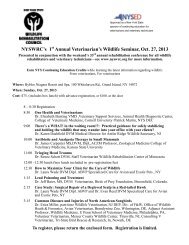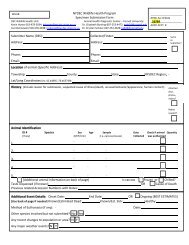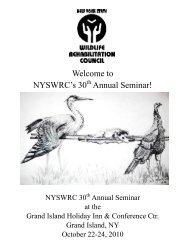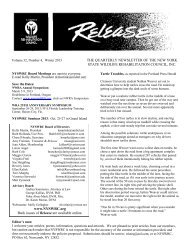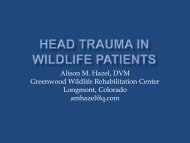Conference Booklet - New York State Wildlife Rehabilitation Council
Conference Booklet - New York State Wildlife Rehabilitation Council
Conference Booklet - New York State Wildlife Rehabilitation Council
You also want an ePaper? Increase the reach of your titles
YUMPU automatically turns print PDFs into web optimized ePapers that Google loves.
PROGRAM ABSTRACTS/DESCRIPTION<br />
SPECIAL SESSION FOR VETERINARIANS ONLY<br />
SUNDAY<br />
15<br />
<strong>New</strong> <strong>York</strong> <strong>Wildlife</strong> Health Program - Dr. Elizabeth Bunting/Patrick Martin<br />
DEC's <strong>New</strong> <strong>York</strong> <strong>State</strong> <strong>Wildlife</strong> Health Program is a partnership with Cornell University College of<br />
Veterinary Medicine Animal Health Diagnostic Center (AHDC). The goal of the program is to identify and<br />
monitor both infectious and non-infectious diseases in wildlife populations, to put that information to use in<br />
making sound management decisions, and to intervene when necessary to ensure that <strong>New</strong> <strong>York</strong> has<br />
sustainable, robust and diverse wildlife populations for the future. This session will include a discussion of<br />
interesting cases, new and emerging diseases in <strong>New</strong> <strong>York</strong>, disease surveillance strategies, program<br />
initiatives, and research projects.<br />
There’s a WHAT in the Waiting Room!? Practical Guidance for Safely Stabilizing and Holding the<br />
<strong>Wildlife</strong> That May Wander Into Your Office With Your Clients - Dr. Karen Dashfield<br />
As a veterinarian you never know what you are going to find in your waiting room, and the frequency of<br />
requests to assist with wildlife is on the rise. We will quickly review the legal issues involved with handling<br />
wildlife, accurate identification, triage and stabilization techniques that will allow you to provide an<br />
invaluable public service while being sure to “do no harm.”<br />
Antibiotic and Analgesic Therapy in Small Mammals - Dr. James Carpenter<br />
Pharmacokinetic studies in wild small mammals are lacking and, therefore, most of the dosages used in these<br />
species are based on extrapolation from domestic mammals (and, rarely, from exotic small mammals),<br />
empirical data, observations, and experience. Because drug uptake depends on factors such as age, sex,<br />
physiology, disease state, diet, etc., it is important for us as wildlife veterinarians to know some of the<br />
pharmacobiologic, physiologic, and anatomic characteristics of these species. It should also be noted that<br />
almost all of the drugs used in wild small mammals are extralabel. This review outlines drug administration<br />
sites, compounding, and some of the issues involved in selecting an antibiotic and analgesic agent (including<br />
nonsteroidal, anti-inflammatory drugs; NSAIDs) for use in wild small mammals. It should be especially<br />
noted that in recent years wildlife veterinarians have become very proactive in providing pain management<br />
for their wildlife patients because we have learned that analgesics (including NSAIDs) reduce post-trauma/<br />
postsurgical/chronic pain, reduce stress and promote healing, and result in smoother postsurgical recoveries<br />
and a more rapid return to normal behavior.<br />
How to Maximize Your Clinic for the Care of <strong>Wildlife</strong> - Dr. Laura Wade<br />
So you really want to help that injured rabbit that your client drops off, but don't know how you can find the<br />
time in your busy day? Or maybe you enjoyed handfeeding baby robins in vet school but you don't know<br />
how you can keep your hospital from turning into a nestling nursery during the spring? Dr. Wade will share<br />
some of her experiences with working with wildlife successfully in a busy hospital and give you some tips on<br />
how you can do it too!<br />
Lead Toxicity in Raptors - Dr. Jeff Baier<br />
Lead toxicity is an increasingly recognized problem in raptors.This lecture will cover the approach utilized to<br />
diagnose and treat this problem at the Birds of Prey Foundation in Broomfield, CO. This discussion will<br />
cover the species affected, methods of diagnosis and methods of treatment utilized in the treatment of lead<br />
toxicity.<br />
Triaging Head Trauma - Dr. Renee Schott<br />
Head and spinal trauma are a common finding in injured wildlife. Many cases can be triaged on admission<br />
and the prognosis decided quickly. In a case-based format, the lecture will cover how to quickly and<br />
effectively triage the head and spinal trauma patient so that a prognosis can be determined on admission.<br />
Case Study: Surgical Repair of a Degloved Scalp in a Red-Tailed Hawk - Dr. Laura Wade/Dr. Evan<br />
Reed<br />
A red tailed hawk was presented with a degloving injury over the entire dorsal surface of the head. Initial<br />
attempts to allow for granulation and healing by second intention were unsuccessful. Therefore, a skin flap<br />
transposition surgery was performed to cover the defect. This lecture will discuss the treatment, surgical<br />
procedure and aftercare of the red-tailed hawk prior to full healing and release.<br />
Common Diseases and Injuries of North American Songbirds - Dr. Erica Miller<br />
This presentation addresses illnesses and injuries for which North American passerines are commonly<br />
presented to a wildlife rehabilitation facility. The information provides a quick reference for information<br />
regarding the cause, transmission, diagnosis and treatment of these more commonly encountered diseases<br />
(and parasites), including those that are zoonotic. Sample cases are also presented in this overview, and<br />
references for additional information are provided.



